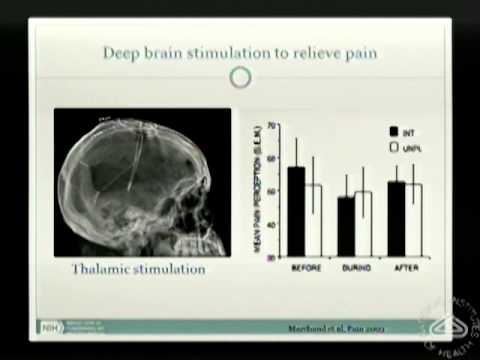Okay. Another type of CAM therapy, stimulation therapies. Acupuncture, and I put neurostimulation into this because I think it’s important in that again, it’s a therapy that’s not a pharmacotherapy and it’s a therapy that we think has a big placebo effect involved in it. Deep brain stimulation for the relief of pain. This is a patient that has an electrode implanted in his thalamus, and that he can stimulate himself, self-stimulate. And there are patients that get thalamic stimulation, others that get motor cortex stimulation, there have been others that got – they tried to stimulate in the periacqueductal grey knowing that’s an important part of pain modulatory circuitry but it didn’t work so well in patients. It works well in rats, but when you stimulate in patients, even though it reduced their pain, they had this horrible feeling of impending doom and they said never stimulate there again so that didn’t really work out so well.
But stimulating the thalamus and motor cortex has been used. So what we did is we took patients that had had successful treatment with this deep brain stimulation for years and then we brought them into the lab and we said okay, we’re going to test out some new stimulation parameters to see if these new parameters are better or worse than your current parameters. So first of all, we just stimulated them using their normal parameters, and we had the stimulator turned off, and there’s their pain ratings, intensity of unpleasantness; stimulator on, intensity of unpleasantness goes down. You turn it back off, and it goes back up. That’s what you expect. But then – again, this just shows that when you do this, that’s from the last slide. But then we basically told them we had them in front of the oscilloscope and we had these other wave forms, and we said this is a new pattern, you may or may not feel it, because you get a paresthesia with the thalamic stimulation, a tingling sensation in the area where the stimulator is.
So basically we turned off the stimulator and we basically got the same thing. This was the ratings before we turned it off. We even got a bigger effect than with their normal stimulation and that even lasted a little bit longer than the normal stimulation. So this was the new stimulation that had even a more profound effect or as profound as their normal stimulation. And the neurosurgeons always say, well you can’t do a placebo control, because they can feel the stimulation and if you don’t turn it on, they can’t feel it. And we told them, you may or may not feel this new stimulation. But lo and behold, they felt the new stimulation, which was actually no stimulation. They still felt the paresthesia. And so here are the paresthesia ratings and how they relate to their pain perception; and the bigger the paresthesia, the more – what’s the inverse? – the lower the pain ratings, and you found the same thing with the placebo paresthesias.
We even had one patient that said stop the stimulation, it’s too strong. So it’s real, it’s in our systems that we have this natural placebo responsiveness, which I’ll just get to a little later to go into really what’s happening with placebo. It’s not imaginary, it’s not because the person is crazy, and we’ll get there in a little bit. Acupuncture is another type of stimulation that seems to have a strong placebo effect. This is from the group at Harvard, and they were doing – they had verum stimulation and placebo stimulation, and they had it at the meridian site and a nonsite. So here with the verum stimulation, when the person has a very high expectation of pain relief, you get a nice pain relief, and at the correct site but not at the incorrect site, but if they have a low expectation, it goes away.
But if you do placebo stimulation, again, you’re getting an effect, not quite as strong, but you’re getting an effect as long as you have a high expectation even without having the real needling. So although you have these effects in both cases, when they did the brain imaging, what they found is that the real acupuncture actually activated different parts of the brain than the placebo-expectation-related acupuncture. So even though both worked, they may not be working through the same mechanisms. And this is something that, again, hasn’t been followed up on, but I think it’s important.
Just because you get the same behavioral output doesn’t mean it’s the same mechanisms happening in the brain. And I think it’s really something that needs to be investigated further..
